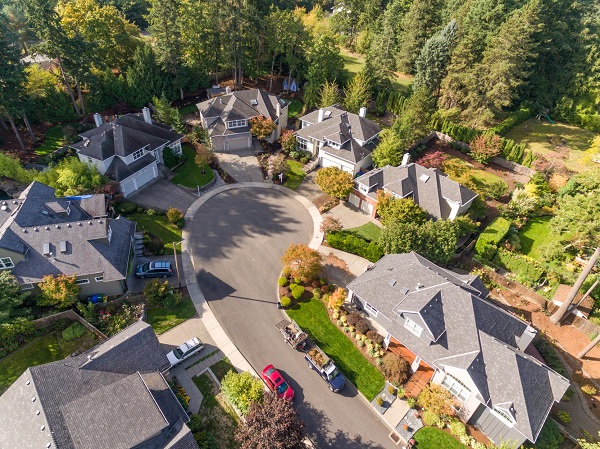 With flexible seating options and innovative classroom designs, more and more teachers are re-considering how they set up their classroom to foster improved learning environments. If classrooms are communities, why not look at urban planning and sociology research to help us design classrooms?
With flexible seating options and innovative classroom designs, more and more teachers are re-considering how they set up their classroom to foster improved learning environments. If classrooms are communities, why not look at urban planning and sociology research to help us design classrooms?Thomas Hochschild, a sociologist, has publish research in the Journal of Urban Planning and Development (March 2015) that promotes the social benefits of cul-de-sacs; he has found that cul-de-sacs encourage attitudinal and behavioral cohesion among their residents; in short, residents living in a cul-de-sac are more likely to "love their neighbors."
After studying families living on different types of streets, Hochschild found that 31% of cul-de-sac residents felt strongly about the following statement: "The friendships ... I have with my immediate neighbors mean a lot to me." Only 5% of through-street residents felt the same way. Likewise, 26% of cul-de-sac residents strongly agreed with "friendship runs deep between me and my immediate neighbors." Nobody living on a through-street "strongly agreed" with this statement. In addition, his findings included cul-de-sac residents expressing a stronger feeling of belonging and safety, they shared with and cared for each other more; essentially, those who lived on cul-de-sacs practiced "neighborliness" more than residents on other street types. Hochschild concluded that street design facilitates positive community development.
- A summary of Hochschild's research can be found HERE.
- Abstract of the journal article can be found HERE.
Benefits of Cul-de-Sac Classrooms
If you set up your room to look like a cul-de-sac, I would hope that the classroom design would help facilitate some of the following cul-de-sac qualities.
Everyone is Noticed and Welcome
When a car enters a cul-de-sac it seems like everyone notices because they are valued residents or invited guests (or lost travelers). Cul-de-sacs have "community eyes" in which everyone is looking out for each other as family. Classrooms should notice those who enter a classroom, welcome them home, or invite them into the community (or help them find the right classroom if they are lost). The classroom climate should be hospitable and the message should clearly be ... "you are welcome here."
This is a Safe Place
One of the blessings of living on a cul-de-sac is the feeling of safety when you are home. Kids can play on the street because of the lack of traffic, neighbors are looking out for each other ("community eyes"), and there is no "stranger danger" because everyone knows each other. Likewise, a classroom where everyone feels safe to play, where others look out for each other, and everyone is known creates a powerful learning environment. A safe learning environment sends the message ... "come out to play, explore, discover and even make mistakes because we are looking out for you."
Neighbors are Sharing and Caring
Residents on a cul-de-sac are more likely to borrow items from their neighbors and ask them to watch their homes (pick up mail, water plants, etc.) when they are gone. How can a classroom become sharing/caring neighborly? Healthy learning environments are ones that are willing to share (and borrow) from each other, both physically (classroom supplies) and intellectually (collaborative learning). In addition, a cul-de-sac classroom would notice when students are absent, and other students would look after the "learning home" of that student by sharing notes, collecting papers, and even welcoming them back.
People are Driving Slowly
People drive differently in cul-de-sacs than they do on through-streets. People driving into a cul-de-sac usually drive slowly because they are ending their journey at home and looking out for their neighbors playing in the street. Classrooms should also involve "slow driving." Unfortunately, sometimes classrooms feel like a freeway with teachers and students driving as fast as they can to get to a destination; slow down, take your time, learn deeply, reflect on your learning.
People Stay for Awhile
Cul-de-Sacs do not have "grab n go" convenience stores, fast food restaurants, or gas stations, they only have residences. For the most part, people arriving in a cul-de-sac are planning to stay for awhile ... because it is their home or because they are welcomed guests invited over for a meal. Students in a classroom should plan to stay awhile; it should not be a quick stop because learning in relationship takes time and an ethos of everyone being present together. However, all too often, students look at school as a grab n go store to pick up a credit on their way to graduation. A cul-de-sac classroom would say: "Take a seat on the porch, let me get you some lemonade, and let's have a rich conversation about learning."
This analogy of a "Cul-de-Sac Classroom" can go on for some time ... with HOA rules, neighborhood watch, and mowing lawns, but those tend to stretch the analogy. I know that there is also the "shadow side" of cul-de-sacs (btw, not all sociologists and urban planners agree that cul-de-sacs are healthy), and those negatives can definitely seep into cul-de-sac classrooms.
However, I would love to explore cul-de-sac classrooms more intentionally (what do they even look like?). If you, at the beginning of the school year, are looking for an alternative classroom design, try a cul-de-sac classroom, and let me know if it enhances your classroom community.
No comments:
Post a Comment